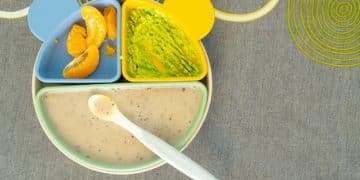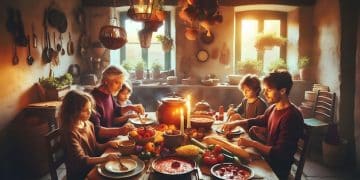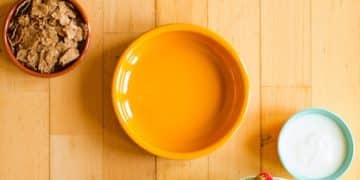Batch Cooking for Busy Parents: 5 Healthy Dinners in 2 Hours
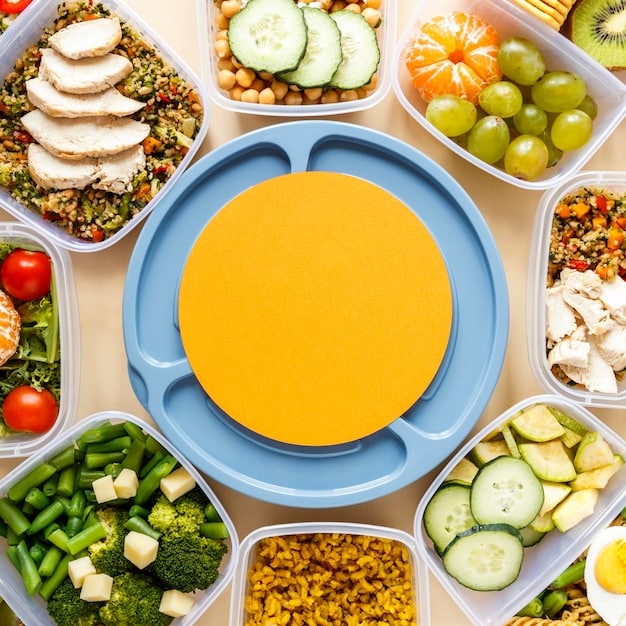
Batch cooking is a smart strategy for busy parents to prepare multiple healthy dinners in a single cooking session, saving time and ensuring nutritious meals are readily available throughout the week.
Is weeknight dinner prep a constant battle? Discover how batch cooking can transform your hectic schedule into a streamlined, stress-free process, delivering delicious and healthy meals for your family with minimal effort.
What is Batch Cooking and Why is it Perfect for Busy Parents?
Batch cooking, at its core, is preparing multiple meals or meal components in one go. This isn’t just cooking a large pot of chili; it’s a strategic approach to maximizing your time in the kitchen and streamlining your weekly meal prep.
For busy parents, the benefits of batch cooking are immense. It eliminates the daily “what’s for dinner?” dilemma, reduces reliance on takeout or processed foods, and ensures healthier, home-cooked meals are always on the table. But beyond convenience, batch cooking can also save money and reduce food waste.
Benefits of Batch Cooking:
- Saves Time: Spend a few hours on the weekend to prep meals for the entire week.
- Reduces Stress: No more last-minute dinner scrambles.
- Promotes Healthy Eating: Control ingredients and portion sizes.
- Saves Money: Less takeout and reduced food waste.
By dedicating a specific time slot to batch cooking, you’re investing in your family’s health and well-being, freeing up valuable time during the week for other priorities.
In conclusion, batch cooking is an incredibly effective method for busy parents seeking to provide nutritious, home-cooked meals without sacrificing valuable time and energy.
Planning Your Batch Cooking Session: The Key to Success
Effective batch cooking starts with a solid plan. This isn’t about blindly cooking everything in your fridge; it’s about carefully selecting recipes that complement each other, making efficient use of ingredients, and organizing your cooking process.
Start by choosing 5-7 recipes that can be easily prepped or cooked in batches. Consider recipes that share some ingredients to minimize waste and simplify your shopping list. Think about dishes like soups, stews, casseroles, pasta sauces, and pre-cooked grains or proteins.
Step-by-Step Planning:
- Choose Recipes: Select 5-7 recipes that are suitable for batch cooking.
- Create a Shopping List: Organize your list by grocery store sections to save time.
- Schedule Your Session: Block out 2-3 hours on a weekend or weekday evening.
- Gather Containers: Have enough airtight containers for storing your meals.
Once you have your recipes and shopping list ready, consider the order in which you’ll cook each dish. Start with items that take the longest to cook, such as roasting vegetables or simmering sauces, and then move on to quicker tasks.
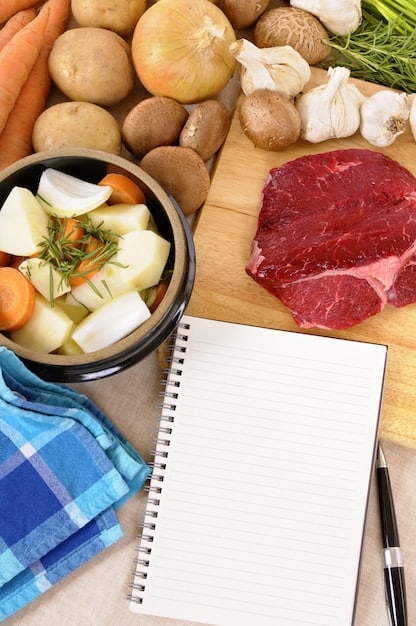
Remember, planning is paramount. By investing time upfront, you significantly reduce chaos during the cooking process and ensure a smooth, efficient batch cooking session.
5 Delicious and Healthy Dinner Ideas Perfect for Batch Cooking
Ready to embrace batch cooking but unsure where to start? Here are 5 dinner ideas that are easy to prepare, healthy, and perfect for feeding a family during the week.
These recipes are designed to be versatile and adaptable, allowing you to customize them based on your family’s preferences and dietary needs. Consider swapping proteins, adding different vegetables, or adjusting spices to create your own unique variations.
Batch Cooking Dinner Ideas:
- Chicken and Vegetable Stir-Fry: Pre-chop vegetables like broccoli, carrots, and bell peppers. Cook chicken in batches and store separately. Combine when ready to serve.
- Lentil Soup: This hearty soup can be made in a large pot and stored for several days. Add different vegetables or spices for variety.
- Turkey Meatballs with Marinara Sauce: Prepare the meatballs in advance and freeze them. Cook the marinara sauce in a large batch and store.
- Black Bean Burgers: These vegetarian burgers can be made ahead and cooked when needed. Serve on buns with your favorite toppings.
- Quinoa Salad with Roasted Vegetables: Roast a variety of vegetables like sweet potatoes, Brussels sprouts, and butternut squash. Combine with cooked quinoa and a simple vinaigrette.
These are just a few examples, but the possibilities are endless. The key is to choose recipes that are relatively simple to prepare in large quantities and that can be easily reheated or assembled when needed.
In conclusion, these dinner ideas provide a solid foundation for your batch cooking endeavors, offering a variety of flavors and nutritional benefits for your family’s enjoyment.
Time-Saving Tips and Tricks for Efficient Batch Cooking
While batch cooking is inherently efficient, there are several tips and tricks you can employ to maximize your time in the kitchen and streamline the entire process.
One of the most important aspects of efficient batch cooking is proper organization. Before you even start cooking, gather all your ingredients, tools, and containers. Having everything readily available minimizes wasted time and prevents frantic searches mid-cooking.
Tips for Speeding Up the Process:
- Mise en Place: Chop all vegetables and measure ingredients before you start cooking.
- Utilize Appliances: Use a food processor to quickly chop vegetables or a slow cooker for hands-off cooking.
- Double Recipes: If a recipe is a hit, double or triple it for even more leftovers.
- Freeze Portions: Freeze individual portions for easy grab-and-go lunches or single-serving dinners.
Another great tip is to utilize your freezer effectively. Batch cook items like soups, sauces, and meatballs, then freeze them in individual portions for easy reheating. This is especially helpful for those busy weeknights when you have limited time.
In summary, by implementing these time-saving tips and tricks, you can significantly enhance your batch cooking efficiency and further reduce your time spent in the kitchen during the week.
Storing and Reheating Your Batch-Cooked Meals Safely
Proper storage and reheating are crucial to ensure the safety and quality of your batch-cooked meals. After spending time preparing delicious and healthy dinners, you want to be confident that they will remain safe and enjoyable to eat throughout the week.
The first rule of thumb is to cool your cooked food quickly. Divide large portions into smaller containers to allow for faster cooling in the refrigerator. Aim to get the food below 40°F (4°C) within two hours of cooking.
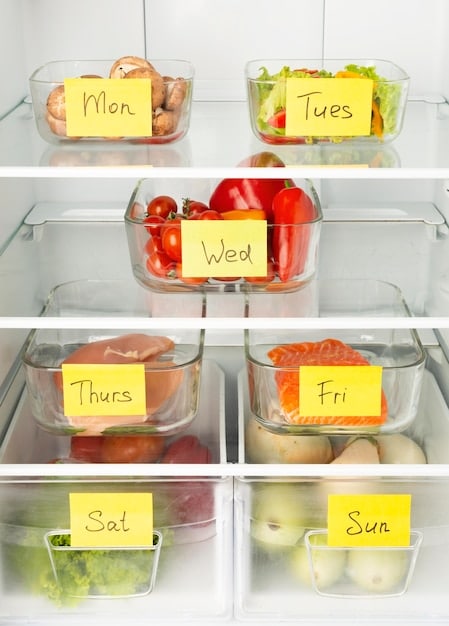
Safe Storage Guidelines:
- Cool Quickly: Divide food into smaller containers for faster cooling.
- Refrigerate Promptly: Store cooked food in the refrigerator within two hours of cooking.
- Use Airtight Containers: Prevent contamination and maintain freshness.
- Label and Date: Keep track of when the food was cooked.
When reheating, ensure that food is heated thoroughly to an internal temperature of 165°F (74°C). Use a food thermometer to check the temperature. You can reheat food in the microwave, oven, or on the stovetop.
In conclusion, following these guidelines for storing and reheating your batch-cooked meals ensures that your food remains safe, delicious, and ready to enjoy whenever hunger strikes.
Adapting Batch Cooking to Different Dietary Needs and Preferences
One of the great things about batch cooking is its flexibility. It can be easily adapted to accommodate different dietary needs and preferences, ensuring that everyone in the family enjoys delicious and healthy meals that meet their specific requirements.
Whether you’re dealing with allergies, sensitivities, or specific dietary philosophies, batch cooking allows you to customize your recipes and meal prep to suit individual needs. The key is to start with versatile base recipes and then modify them as needed.
Adaptation Strategies:
- Allergies: Substitute ingredients to accommodate allergies (e.g., use gluten-free pasta or dairy-free alternatives).
- Vegetarian/Vegan: Replace meat with plant-based proteins like lentils, beans, or tofu.
- Low-Carb: Focus on protein and non-starchy vegetables.
- Spice Levels: Adjust spices to cater to different heat preferences.
For example, if you’re making a pasta sauce, you can easily divide it into two batches, one with meat and one without for vegetarian family members. Or, if someone has a gluten allergy, you can use gluten-free pasta or serve the pasta with a side of vegetables instead.
Essentially, understanding how to adapt recipes is key to making batch cooking work seamlessly for diverse dietary needs, promoting a healthier and more inclusive eating environment for your family.
| Key takeaway | Brief Description |
|---|---|
| ⏰ Time Savings | Batch cooking reduces daily dinner preparation time. |
| 🥗 Healthier Meals | It allows control over ingredients and portion sizes. |
| 💰 Cost-Effective | Reduces reliance on takeout and minimizes food waste. |
| 👪 Dietary Adjustments | Batch cooking is adaptable to various dietary needs. |
FAQs
▼
Batch cooking involves preparing multiple meals or ingredients at once to save time. It’s strategically cooking large quantities of food to be used throughout the week or frozen for later use.
▼
Cool food quickly, divide into smaller containers, and refrigerate promptly within two hours of cooking. Use airtight containers and label them with dates to maintain freshness and safety.
▼
Soups, stews, chili, pasta sauces, pre-cooked grains, and marinated meats are excellent for batch cooking. These can be stored easily and combined with fresh ingredients for complete meals.
▼
Yes, batch cooking can easily accommodate dietary needs. Adapt recipes by swapping ingredients to suit allergies, preferences, or dietary requirements (e.g., gluten-free, vegetarian, low-carb options).
▼
Refrigerated batch-cooked meals should be eaten within 3-4 days. Properly frozen meals can last 2-3 months. Always label with the date to keep track of freshness and safety.
Conclusion
Incorporating batch cooking into your routine can be a game-changer for busy parents. By dedicating a few hours each week to planning, prepping, and cooking, you can ensure that your family enjoys nutritious, home-cooked meals without sacrificing precious time and energy. Embrace the flexibility and convenience of batch cooking to transform your mealtime experience.


